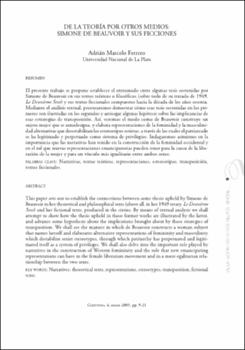De la teoría por otros medios: Simone de Beauvoir y sus ficciones
Autor
Ferrero, AdriánFecha
2005Resumen
El presente trabajo se propone establecer el entramado entre algunas tesis sostenidas por
Simone de Beauvoir en sus textos teóricos o filosóficos (sobre todo de su tratado de 1949,
Le Deuxième Sexe) y sus textos ficcionales compuestos hacia la década de los años sesenta.
Mediante el análisis textual, procuraremos demostrar cómo esas tesis sostenidas en los primeros
son ilustradas en los segundos y arriesgar algunas hipótesis sobre las implicancias de
esas estrategias de transposición. Así, veremos el modo como de Beauvoir construye un
sujeto mujer que se autodesigna, y elabora representaciones de la feminidad y la masculinidad
alternativas que desestabilizan los estereotipos sexistas, a través de los cuales el patriarcado
se ha legitimado y perpetuado como sistema de privilegios. Indagaremos asimismo en la
importancia que las narrativas han tenido en la construcción de la feminidad occidental y
en el rol que nuevas representaciones emancipatorias pueden tener para la causa de la liberación
de la mujer y para un vínculo más igualitario entre ambos sexos. This paper sets out to establish the connections between some thesis upheld by Simone de
Beauvoir in her theoretical and philosophical texts (above all, in her 1949 treaty, Le Deuxième
Sexe) and her fictional texts, produced in the sixties. By means of textual analysis we shall
attempt to show how the thesis upheld in those former works are illustrated by the latter,
and advance some hypothesis about the implications brought about by those strategies of
transposition. We shall see the manner in which de Beauvoir constructs a woman subject
that names herself and elaborates alternative representations of femininity and masculinity
which destabilize sexist stereotypes, through which patriarchy has perpetuated and legitimated
itself as a system of privileges. We shall also delve into the important role played by
narratives in the construction of Western femininity and the role that new emancipating
representations can have in the female liberation movement and in a more egalitarian relationship
between the two sexes.





